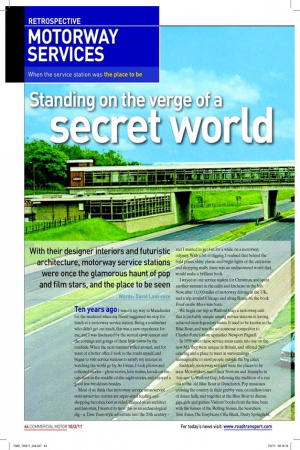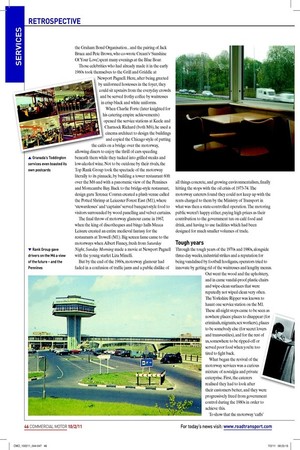secret world
Page 31

Page 32

Page 33

If you've noticed an error in this article please click here to report it so we can fix it.
With their designer interiors and futuristic architecture, motorway service stations were once the glamorous haunt of pop and film stars, and the place to be seen
Words: David Lawrence Ten years ago I was on my way to Manchester
for the weekend when my friend suggested we stop for lunch at a motorway service station. Being a southerner who didn’t get out much, this was a new experience for me, and I was fascinated by the surreal environment and the comings and goings of these little towns by the roadside. When the next summer rolled around, and for want of a better offer, I took to the roads myself, and began to visit service stations to satisfy my interest in watching the world go by. As I went, I took photos and collected stories – ghost stories, love stories, knock-on-thecab-door-in-the-middle-of-the-night-stories, and enjoyed a good few breakfasts besides.
Most of us think that motorway service areas/service stations/service centres are super-sized feeding and shopping factories, best avoided. Trained as an architect and historian, I wanted to treat this as an archaeological dig – a Time Team-style adventure into the 20th century –
and I wanted to get lost for a while on a motorway odyssey. With a bit of digging, I realised that behind the bold prices, shiny plastic and bright lights of the cafeterias and shopping malls, there was an undiscovered world that would make a brilliant book.
I stayed at one service station for Christmas, and spent another summer in the cafés and kitchens on the M6. Now, after 11,000 miles of motorway driving in the UK, and a trip around Chicago and along Route 66, the book Food on the Move was born.
We begin our trip at Watford Gap, a motorway café that is probably unique among service stations in having achieved near-legendary status. It used to be known as the Blue Boar, and was the no-nonsense competitor to Charles Forte’s more upmarket Newport Pagnell.
In 1959 when these service areas came into use on the new M1, they were unique in Britain, and offered 24/7 catering and a place to meet in surroundings unimaginable to most people outside the big cities.
Suddenly, motorway services were the places to be seen. Motorbikers raced their Nortons and Triumphs in ‘ton-ups’ to Watford Gap, following the tradition of a run out to the old Blue Boar at Dunchurch. Pop musicians crossing the country in their grubby vans, on endless tours of dance halls, met together at the Blue Boar to discuss gigs, girls and guitars. Visitors’ books from the time buzz with the names of the Rolling Stones, the Searchers, Tom Jones, The Easybeats, Cilla Black, Dusty Springield, the Graham Bond Organisation... and the pairing of Jack Bruce and Pete Brown, who co-wrote Cream’s ‘Sunshine Of Your Love’, spent many evenings at the Blue Boar.
Those celebrities who had already made it in the early 1960s took themselves to the Grill and Griddle at Newport Pagnell. Here, after being greeted by uniformed hostesses in the foyer, they could sit upstairs from the everyday crowds and be served frothy coffee by waitresses in crisp black and white uniforms.
When Charlie Forte (later knighted for his catering empire achievements) opened the service stations at Keele and Charnock Richard (both M6), he used a cinema architect to design the buildings and copied the Chicago style of putting the cafés on a bridge over the motorway, allowing diners to enjoy the thrill of cars speeding beneath them while they tucked into grilled steaks and low-alcohol wine. Not to be outdone by their rivals, the Top Rank Group took the spectacle of the motorway literally to its pinnacle, by building a tower restaurant 60ft over the M6 and with a panoramic view of the Pennines and Morecambe Bay. Back to the bridge-style restaurant, design guru Terence Conran created a plush venue called the Potted Shrimp at Leicester Forest East (M1), where ‘stewardesses’ and ‘captains’ served banquet-style food to visitors surrounded by wood panelling and velvet curtains.
The inal throw of motorway glamour came in 1967, when the king of discotheques and bingo halls Mecca Leisure created an entire medieval fantasy for the restaurants at Trowell (M1). Big screen fame came to the motorways when Albert Finney, fresh from Saturday Night, Sunday Morning made a movie at Newport Pagnell with the young starlet Liza Minelli.
But by the end of the 1960s, motorway glamour had faded in a confusion of trafic jams and a public dislike of all things concrete, and growing environmentalism, inally hitting the stops with the oil crisis of 1973-74. The motorway caterers found they could not keep up with the rents charged to them by the Ministry of Transport in what was then a state-controlled operation. The motoring public weren’t happy either, paying high prices as their contribution to the government tax on café food and drink, and having to use facilities which had been designed for much smaller volumes of trade.
Tough years
Through the tough years of the 1970s and 1980s, alongside three-day weeks, industrial strikes and a reputation for being vandalised by football hooligans, operators tried to innovate by getting rid of the waitresses and lengthy menus. Out went the wood and the upholstery, and in came vandal-proof plastic chairs and wipe-clean surfaces that were reputedly not wiped clean very often. The Yorkshire Ripper was known to haunt one service station on the M1. These all-night stops came to be seen as nowhere places: places to disappear (for criminals, migrants, sex workers), places to be somebody else (for secret lovers and transvestites), and for the rest of us, somewhere to be ripped-off or served poor food when you’re too tired to ight back.
What began the revival of the motorway services was a curious mixture of nostalgia and private enterprise. First, the caterers realised they had to look after their customers better, and they were progressively freed from government control during the 1980s in order to achieve this. were welcoming places, another change in décor took place. Everything went farmhouse, home-grown and whole-grain: wood furniture, plastic lowers, pot pourri in the toilets, optional brown bread sandwiches, and new buildings made to look like massive barns. When regulation diminished, catering chains were imported from the towns to provide recognisable brands for road users. We got KFC, Wimpy and Burger King to accompany Little Chef and Happy Eater.
Restaurants went open plan, then entire service stations went free-low as Moto, Welcome Break and Roadchef developed airport-style steel and glass sheds to shelter concourses in which travellers are encouraged to graze, or drift, between food and shop outlets.
Private areas available to truck and coach drivers were reduced, raising the question of whether the original idea of segregating different groups of road users was beneicial or discriminatory. The roadside cafés that had served truckers so well in the days before motorways continue to provide comfort and prices unequalled by the service areas, but tend to be avoided by 21st century private motorists who do not appreciate the down home, if variable, comforts of these wayside retreats. Now service stations offer high-street brands at prices that are little different form railway stations or airports, and for most travellers they remain the only convenient respite available. We can get a reasonably good coffee, ind a fortune-telling machine and a disposable toothbrush, buy gifts for partners, parents and grandparents, and stop for ive minutes to
watch the extraordinary world of the motorway service area pass by. ■





































